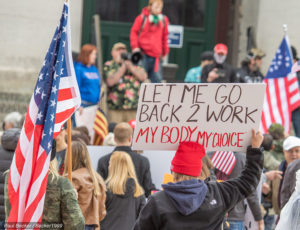What Will Be the Human Cost of Reopening the Economy?
 A protester at the "Freedom or Bust May Day Rally" in Columbus, OH on May 1, 2020. (photo by Paul Becker via Flickr)
A protester at the "Freedom or Bust May Day Rally" in Columbus, OH on May 1, 2020. (photo by Paul Becker via Flickr) When the first of the COVID-19 shutdown-related protests broke out in Michigan, Virginia, and Minnesota last month, any other president would have urged Americans to comply with the stay-at-home orders instituted by states to flatten the coronavirus curve. But as we’ve all come to learn, President Donald Trump doesn’t merit such a reasonable expectation. Sure enough, it didn’t take him long to take to Twitter and incite insurrection against three duly elected Democratic governors, encouraging Americans to “liberate” their states.
Since those tweets, the confirmed COVID-19 cases in the US have surpassed one million, while the recorded deaths are now at 68,279 (as of this writing), with no signs of abating. Likewise, agitation to reopen the economy has grown louder, as unmasked demonstrators have taken to the streets in at least ten states across the country—including California, New York, Florida, and Colorado. On April 30 in Michigan, men armed with assault weapons and others, a number of whom reportedly bore swastikas, Confederate flags, and nooses, descended upon the state capitol, demanding an end to the coronavirus lockdown. It seemed that these Americans heeded Trump’s words, against good judgment and public health guidelines, to demand their “liberation.”
Surfing through the gallery of homemade signs from the protests, jarring slogans (e.g., “This is America, Not Nazi Germany. Open Now. Trump, 2020”) immediately stick out. However, a closer look reveals what appears to be a concerted effort by Trump and Attorney General William Barr to divide and conquer. Together, they are tapping into an existing political split and a swelling polarization around how to respond to the coronavirus pandemic by fomenting rebellion on two fronts.
First, Barr is peddling a religious right argument by describing public health and safety measures as “draconian” and threatening to scrutinize “restrictions on our liberty” more closely, including supposed restrictions on religious freedom. Of course, freedom of religion is not absolute when there is a “compelling state interest” under the First Amendment. Even more, the Daily Beast reports that “On The Hugh Hewitt Show, Barr called stay-in-place orders ‘disturbingly close to house arrest.’ Some governors, he said, are infringing on fundamental rights and constitutional rights in the fight against the coronavirus.”
On the other hand, Trump and his allies are advancing a self-serving utilitarian argument about the economic costs of maintaining the shutdown without duly considering the human costs of an immediate, widespread reopening, which experts have warned could lead to the deaths of “tens of thousands.” This is more than likely since a new projection on Monday by a coronavirus model from the Institute for Health Metrics and Evaluation at the University of Washington predicted an increased death toll of 72,433 COVID-19 deaths in the United States. The spike is reported to be directly linked to “relaxed social distancing and increased mobility in states across the country [that]…have eased restrictions in an attempt to revive a sputtering economy and calm restless residents.”
Examining the economic and health implications of a hasty restarting of the economy, the New York Times last week detailed a deepening of longstanding inequalities suffered by blacks and Latinos as the pandemic persists. The article paints a profoundly bleak portrait of what’s to come if this push for the immediate reopening of the US economy, championed by Trump, happens as feared. Citing economists, it debunks the central point of the president’s economic argument for ending quarantine orders, noting that “hasty moves to restart the economy will simply increase the risks for vulnerable workers without generating significant growth,” and adding,
There is widespread concern that consumers will not travel and spend as freely as they had before the pandemic until therapeutic treatments or a vaccine are developed or testing has ramped up to a degree that gives people confidence that they can resume normal activities without risking infection and death.
The president and his close associates seem to ignore this argument, and the anti-quarantine demonstrations by some of Trump’s most loyal supporters echo the president’s fears for his political prospects and the economic fallout that could result from a more prolonged shutdown. However, these demonstrations are not purely grassroots. A Washington Post investigation into the dark money bankrolling these Trump-rally-like protests reveals a powerful and well-financed conservative network with roots reaching the White House. Indeed, the lockdown measures medical experts deem necessary are the same restrictions Trump characterizes as “too tough” and repeatedly urges Americans to flout.
The president’s messaging suggests that the US economy is more valuable to him than the health and safety of Americans—especially African Americans. Nationwide data released by the Centers for Disease Control and Prevention on April 30 revealed that “30 percent of COVID-19 patients are African American, even though African Americans make up around 13 percent of the population of the United States.” Which makes one wonder: Seeing that the death toll of the pandemic disproportionately impacts African Americans, will they be the greatest human cost of reopening the economy? What if it were Trump’s base that was the most affected by COVID-19 and not black Americans? Would the president and his supporters agitate for the reopening of the economy at all costs, or would they exercise patience and push for more care and caution?
